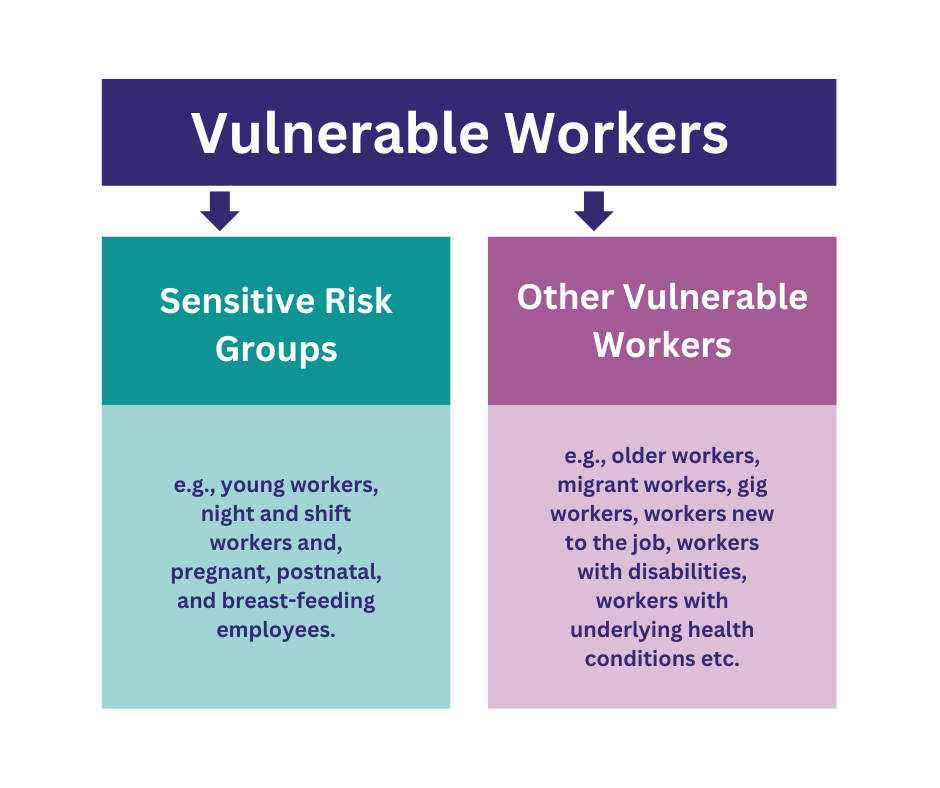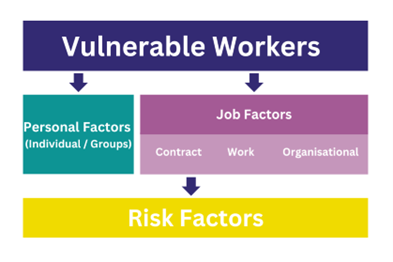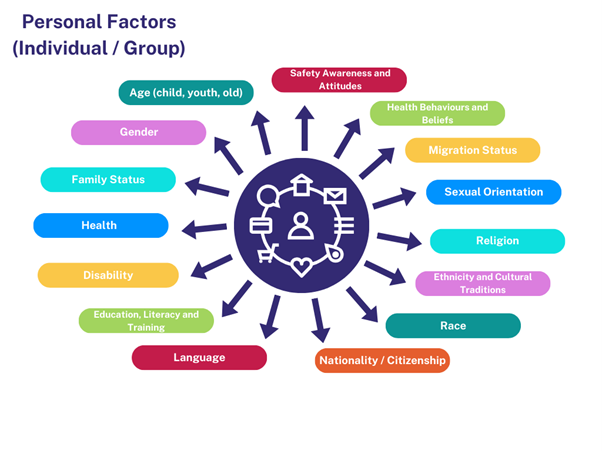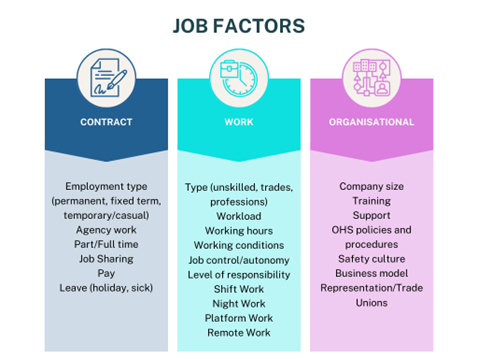Vulnerable Workers
Vulnerable Workers are people who may be particularly sensitive or over exposed to potential health and safety risks in comparison to the general working population. The European Agency for Safety and Health at Work defines vulnerable workers as ‘certain groups who may be more at risk from occupational accidents or ill-health than others or those that have special considerations that may need to be taken account of in a health and safety context’ (2022).

Examples of vulnerable workers include:
- Young people at work*
- New and expectant mothers*
- Night and Shift workers*
- Older workers
- Workers who are new to the job (short tenure workers)
- Inexperienced workers including apprentices.
- Migrant Workers
- Gig/platform workers
- Low qualified workers
- Workers for whom English is not a first language.
- Agency and temporary workers
- Workers with disabilities
- Workers with underlying health issues
- Lone workers
(* Sensitive risk groups)
Every person has the right to a safe workplace where any risks to their health and safety are properly controlled. Some people are more vulnerable to occupational safety and health (OSH) risks due to a variety of personal and job factors. A person can be vulnerable before they start work, or they may become vulnerable during their working life. A person may have several different vulnerabilities linked to specific personal and job factors. In this way, all people reflect a spectrum of vulnerability – with some people having higher or lower levels of vulnerability.
The definition of Vulnerable Workers includes a subset of workers termed ‘Sensitive Risk Groups’.

Understanding Vulnerability
Vulnerable workers are more susceptible to injury or ill health because of specific personal or job factors.
- Personal factors include biological, social, and cultural characteristics.
- Job factors are associated with the person’s status in the enterprise and their work contract, the nature of the work, and certain characteristics of the organisational they work for.
A combination of personal and job factors can lead to specific risk factors, that increase the chance of occupational injury or illness.

Risk factors include:
- Lack of experience/newness to the job
- Poor safety awareness
- Stress
- Lone working
- Presenteeism
- Job/income insecurity
- Job dissatisfaction
- Low job engagement
- Fatigue and overwork
- Poor mental health
- Social isolation
- Bullying, harassment, exploitation, and abuse
- Physically demanding and repetitive work
- Violence and aggression
- Employment protection (weak or none)
- Labour representation (weak or none)
The diagram below provides a summary of the different personal factors which contribute to vulnerability.

The diagram below provides a summary of the different job factors which contribute to vulnerability.

Vulnerable Workers & The Law
Health and safety legislation requires the employer to assess the risks to safety and health at work for all workers, to avoid workplace accident, injury, and ill health. Risk assessment is the first step in the prevention of occupational accidents and ill health.
A risk assessment looks at what can cause harm to people. It identifies if control measures are adequate, or if additional measures are required, to reduce injury and ill health.
Employers are required to develop a safety statement detailing how the safety, health and welfare of employees is protected. The safety statement includes all risk assessments and should be produced in consultation with employees and their representatives.
The Law – Rights & Responsibilities
- Employees, whether they are Irish nationals or migrant workers, have equal rights under Irish health and safety law.
- Temporary or causal workers, whether they are Irish nationals or migrants, have equal rights under Irish health and safety law as fulltime permanent employees.
- Employers have specific obligation to ‘Sensitive Risk Groups’ as defined in the Safety, Health, and Welfare at Work (General Application) Regulations 2007.
- Employers have specific obligation for persons with disabilities as defined in the Safety, Health, and Welfare at Work (General Application) Regulations 2007.
- Workers have a legal right to be represented by Safety Representatives / Trade Unions on Health and Safety issues in the workplace and these representations must be acted upon.
For further information on risk assessment and safety statements, please see our online platform BeSMART.ie
Vulnerable Workers and Reporting
Accident / incident reporting is a key component of effective safety and risk management programs.
Employers should make vulnerable workers aware of their rights to protection and should encourage reporting (including reporting of near misses) to managers and/or those in charge. Vulnerable workers may be less aware of their rights. Or, if they are aware of their rights, they may be reluctant to report health and safety incidents / accidents / concerns, because of the fear that they will lose their job.
Induction training should highlight the importance of reporting for all workers.
Employers are legally obliged to report the injury of an employee arising from an accident while at work, where the injury results in the employee being unable to carry out their normal work for more than three consecutive days, excluding the day of the accident.
Further Information